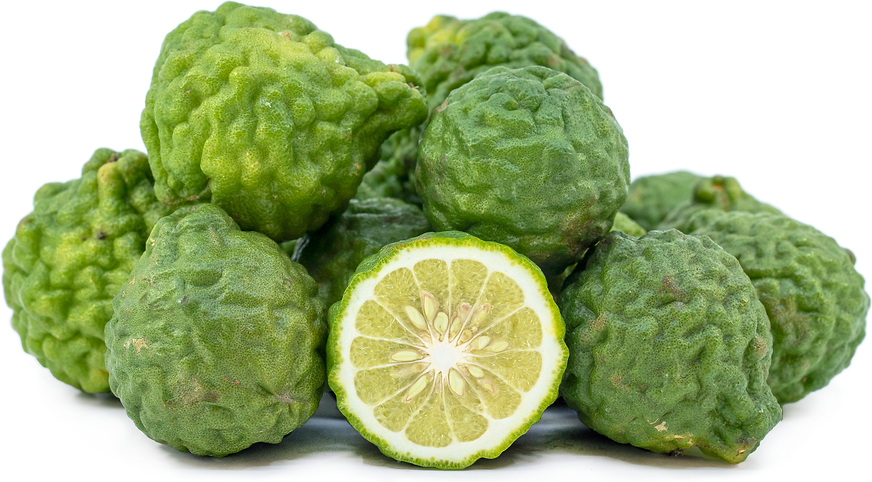


Makrut Limes
Estimated Inventory, lb : 0
Description/Taste
Makrut limes are small in size, averaging 3-5 centimeters in diameter and 5-7 centimeters in length, and are globular to oval in shape with a slightly protruding stem end. The thick rind is covered in small bumps, ridges, and wrinkles and transforms from green to yellow when mature. The flesh is semi-dry, pale green, contains a few inedible, oblong seeds, and is divided into 10-12 segments by thin, white membranes. Makrut limes are aromatic with a floral, perfume-like fragrance and are acidic, bitter, and very sour.
Seasons/Availability
Makrut limes are available year-round, with a peak season in the winter.
Current Facts
Makrut limes, botanically classified as Citrus hystrix, are wrinkled fruits that grow on an evergreen tree that can reach 2-6 meters in height and are members of the Rutaceae family. The species name is Greek for hedgehog, which is reflective of not only the prominent thorns on the tree but also of the bumpy appearance of the fruit itself. There has been some controversy surrounding one of the names of the Makrut lime, Kaffir, as it has derogatory connotations in South African and Middle Eastern cultures, resulting in many retailers opting to call the fruit by its scientific name, Citrus hystrix, or simply Thai lime. Makrut limes are most commonly used for their aromatic rind and zest and are one of the base ingredients in tangy curries and savory dishes in Thai, Laos, Malaysian, and Indonesian cuisine.
Nutritional Value
The largest nutritional benefit of Makrut limes comes from the volatile oils in its rind. The citrus fruit also contains high amounts of citronellol and limonene, which have beneficial anti-inflammatory and anti-bacterial properties.
Applications
Makrut limes are known for their intensely fragrant rind and zest and are used as a finishing element in savory dishes. The zest and pieces of its rind can be finely chopped and then mashed with other ingredients using a mortar and pestle to make curry paste to be added to soups such as tom yum, curries, and stews. The zest can also be used in stir-fries, dressings, salads, or sprinkled over cocktails, infused into vodka, or sliced and floated in beer. In Indonesia, the zest is added to fish cakes and gkaeng bpah, or jungle soup, while whole Makrut limes are used in making rhum arrange or rum with macerated fruit in Madagascar and Le Reunion. In Mauritius, Makrut lime zest can be infused with vanilla ice cream and used in curries with preserved lemon, chile, and garlic. Makrut limes pair well with meats such as poultry, pork, beef, and seafood, herbs and spices such as cumin, cardamom, galangal, ginger, lemongrass, cilantro, curry leaves, basil, mint, tamarind, and turmeric, coconut milk, mushrooms, noodles, and rice. Makrut limes will store in the refrigerator for up to two weeks.
Ethnic/Cultural Info
In addition to adding flavor to culinary dishes, Makrut lime juice is used in shampoos and ointments in Thailand and Malaysia as an invigorating agent. The limes are also used as a natural house cleaner, as a bleach to remove stains, and as a tooth cleaning ingredient to protect gums and teeth. In India, Makrut limes are used in teas to help reduce symptoms of colds and congestion and to help improve digestion.
Geography/History
Limes are native to Asia in an area described as the Indo-Malayan region, which stretches from India to Southeastern Asia, including the Philippines, Malaysia, and Indonesia, and have been growing since ancient times. Makrut limes are thought to be native specifically to Sri Lanka, but since the fruit has been cultivated and hybridized for many generations in Southeast Asia, its exact origin is not truly known. Today Makrut limes are found at local markets and specialty grocers and are mainly cultivated in Southeast Asia, the Philippines, Australia, and in Southern California and Florida in the United States.

Recipe Ideas
Recipes that include Makrut Limes. One
| Saveur |
|
Key Lime Curd |
| Morsels and Musings |
|
Kaffir Lume Syrup |
| Hapa Nom Nom |
|
Kaffir Cooler |
| Rachel Cooks Thai |
|
Thai Inspired Mini Kaffir Lime Tarts |



